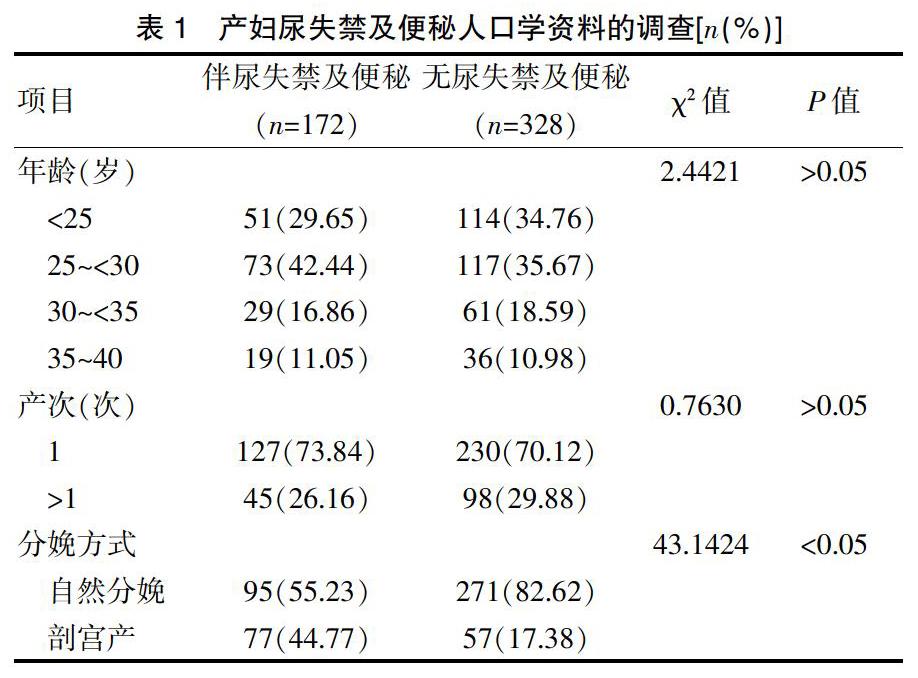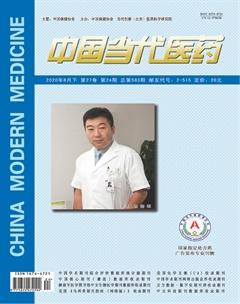我院產婦產后尿失禁及便秘發病情況及認知狀況的調查研究
萬滿紅 連任華 支美芳


[摘要]目的 調查產后尿失禁及便秘的患病率,分析產婦對產后尿失禁及便秘的認知狀況。方法 采用便利抽樣法,選取我院2019年1~3月收治的500名產婦作為研究對象,統計產后尿失禁及便秘的患病率,調查產婦尿失禁及便秘的認知情況。結果 500名產婦中,僅有產后尿失禁者97例(19.40%),產后便秘者46例(9.20%),產后尿失禁伴便秘者29例(5.80%),總患病率為34.40%(172/500)。伴尿失禁及便秘者的年齡、產次與無尿失禁及便秘者比較,差異無統計學意義(P>0.05)。伴尿失禁及便秘者的分娩方式與無尿失禁及便秘者比較,差異有統計學意義(P<0.05)。調查結果顯示,500名產婦的尿失禁及便秘認知情況均較低,伴尿失禁及便秘產婦的認知情況與無尿失禁及便秘產婦比較,差異無統計學意義(P>0.05)。結論 產后尿失禁及便秘的發病率較高,分娩方式可能對產后尿失禁及便秘的發生有影響,產婦對尿失禁及便秘的認知情況較差,需加強健康宣教。
[關鍵詞]產后尿失禁;產后便秘;患病率;調查研究
[中圖分類號] R714.6 ? ? ? ? ?[文獻標識碼] A ? ? ? ? ?[文章編號] 1674-4721(2020)8(c)-0165-03
[Abstract] Objective To investigate the prevalence of postpartum urinary incontinence and constipation, and analyze the maternal cognition of postpartum urinary incontinence and constipation. Methods Using the convenience sampling method, 500 parturients admitted to our hospital from January to March 2019 were selected as the research objects. The prevalence rate of postpartum urinary incontinence and constipation was counted, and the recognition of urinary incontinence and constipation among parturients was investigated. Results In the 500 parturients, 97 cases (19.40%) had only postpartum urinary incontinence, 46 cases (9.20%) had only postpartum constipation, and 29 cases (5.80%) had postpartum urinary incontinence with constipation, the total prevalence rate was 34.40% (172/500). There were no significant differences in age, labor times between the patients with urinary incontinence and constipation and those without urinary incontinence and constipation (P>0.05). There was significant difference in delivery mode between the patients with urinary incontinence and constipation and those without urinary incontinence and constipation (P<0.05). The investigation results showed that the cognitive status of urinary incontinence and constipation in 500 parturients was lower. There was no significant difference in the cognitive status of parturients with urinary incontinence and constipation and those without urinary incontinence and constipation (P>0.05). Conclusion The incidence of postpartum urinary incontinence and constipation is higher, the mode of delivery may affect the occurrence of postpartum urinary incontinence and constipation, and puerperas′awareness of urinary incontinence and constipation is poor, so health education should be strengthened.
[Key words] Postpartum urinary incontinence; Postpartum constipation; Prevalence rate; Investigation and study
——基于1998-2013年的縱向調查數據

